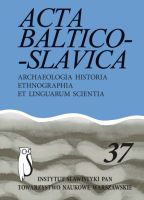Лингво-музыкальная лексика песни как часть этно-культурного наследия былого ВКЛ (Беларусь и приграничья)
The language of folk songs as a part of cultural heritage of the Grand Duchy of Lithuania (Belarus and its border zones)
Author(s): Galina Kutyriowa-Czubala Subject(s): Language and Literature Studies
Published by: Instytut Slawistyki Polskiej Akademii Nauk
Keywords: Western Belarus; historicalcultural layer; rhythmmelodic areas; verse; vocal lexis.
Summary/Abstract: This paper examines the melodic and rhythmic properties of the language of songs in the area defined by the basins of Dvina, Nioman and Pripyat’ rivers. In this area, a lexical stylistic layer has been forming since the ancient times.. This layer has a few distinctive features: (1) domination of a certain type of “atomic” elements (stress feet) of rhythmic morphemes in various syllabic structures; (2) presence of vocal poetic lines based on the measure typical for the area; 3) types of stanzaic organization, reflect the compositional thinking of the culture; (4) a complex of ethnophony, comprising such suprasegmental features as pitch, melody, poetic metre and caesuras, volume dynamics, rhythm. These factors combine to determine the integrity and distinctiveness of the vocal lexis and the whole phonosphere of the area, and its difference from from the lexical styles of other parts of Belarus. The main difference lies in the fact that most songs in the area are performed in the manner of incantatory declamation. This stands in stark contrast to the way in which songs are performed in the area of Dnepr basin – songs in Dnepr basin are accompanied by dancing, and could be defined rather as chants or incantations. Within the linguistic continuum of the area, it is possible to distinguish areas of different foot and rhythm modes, poetic meters, melodic properties, and compositional styles. The territorial divisions in Belarus correspond to a large extent to different dialectal areas. The historical-cultural layer of songs has its origins in ancient times, evolved in times of the Grand Duchy of Lithuania and to a large extent retained its distinctive character to date.
Journal: Acta Baltico Slavica
- Issue Year: 2013
- Issue No: 37
- Page Range: 99-119
- Page Count: 21
- Language: Russian

